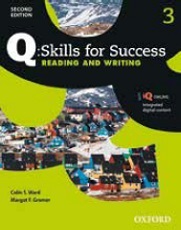A book I've used - Q: Skills for Success Reading and Writing 3 (Second Edition)
Colin S. Ward and Margot F. Gramer
Oxford University Press 2015 This second edition of Level 3 (B1) in the Q: Skills for Success series, designed to equip college and university students with the tools necessary for academic success, contains some welcome new features, such as notetaking, an extended writing syllabus and the use of authentic video.
This second edition of Level 3 (B1) in the Q: Skills for Success series, designed to equip college and university students with the tools necessary for academic success, contains some welcome new features, such as notetaking, an extended writing syllabus and the use of authentic video.
For those unfamiliar with the course, the Q: Skills for Success series consists of paired skills books (Reading & Writing and Listening & Speaking) at each level from Starter to Advanced. Each coursebook is divided into eight units with topics ranging from IT and Marketing to Psychology, Philosophy and Economics. Each unit of this edition has six main components: two reading texts with related tasks, a video, grammar, vocabulary skills, a writing assignment and a writing skills section. Although the book is primarily for work on reading and writing, there is strong integration of all the skills.
The main focus of each unit is a particular reading skill, such as previewing, A book I’ve used scanning, identifying main and supporting ideas. Clear explanations are given of what each skill means and entails. Good sample answers are provided and these lead on to practice activities. As skills are dealt with overtly, students are armed with a sound knowledge of key strategies and can name them. There is also constant recycling and reviewing. The critical thinking aspect of learning is also targeted: each reading has tasks which require students to infer, predict, justify or expand, all of which help train the learner to bean active reader and to interact with the text. There is work on the use of graphic organisers and flow charts, which help learners form an overview of a text and decide on connections between ideas and arguments.
The other focus of each unit is on writing, and there is a gradual development from writing at paragraph level to full essay writing. The breaking up of tasks into manageable steps makes the academic-style writing much less daunting. Students are given guidance in a variety of writing types: cause and effect, discursive/argumentative, analytical, summary and personal response. There are excellent models for each type and good training in revising, editing and peer reviewing. Both the Self-Assessment Checklist and the Peer Review Worksheet online give the student additional practice in critical thinking and evaluation. Learner autonomy is developed by the very worthwhile Online Writing Tutor. Students of mine particularly enjoyed the Quick Write tasks included with the first reading in each unit. They felt similarly about the Write What You Think feature – mainly because these ‘freer’ activities gave them an opportunity to express themselves and their views without having to worry unduly about style and format.
As mentioned, there are dedicated sections in each unit for vocabulary development and once again the focus is overt – students are told exactly what is meant by ‘deducing meaning from context’. There is also good training in dictionary use for identifying word forms and importantly for finding the correct meaning. My students found this useful, particularly as in today’s world of electronic and online dictionaries, it is easy for learners to settle for the first meaning which appears on their screen and misunderstand what they read. Other sections give clear explanations of phrasal verbs and collocations. In my view the texts are exploited well for vocabulary and establish a clear link between reading, writing and vocabulary. As every learner knows, if they don’t extend their vocabulary they will make little progress in any skill.
The grammar points are contextualized in the sense that they are exemplified in one or both of the reading texts or have some relevance to the writing which students will do in that unit. For each point, extra practice activities and explanations are available online. The work on compound/complex sentences and on parallel structures has obvious relevance to a more academic style of writing. However, I felt that the section dealing with the shift between present and past time frames in Unit 5 (and especially the contrast between the past simple and past perfect) was overly condensed given the level of the book and the difficulties which learners often experience in this area. However, the main focus of the book is on reading and writing so additional work can be provided if required.
As I said, Reading and Writing 3 provides solid integration of all the skills.
Speaking is supported with discussion points, and writing involves pair work and peer reviewing, which naturally involves speaking and its various subskills. Each unit also contains online listening and a short video.
For Critical Thinking, there are the Critical Thinking Tips; writing tasks giving practice in forming/expressing opinions, justifying, examining reasons; and the Online Discussion Board and Reflect Sections. Students are trained to monitor and correct themselves and shown how to appraise evidence and evaluate different arguments.
The extensive online resources include Classroom Listening, the Online Discussion Board, the Online Writing Tutor, extra practice for vocabulary, reading skills, pronunciation, writing and grammar, providing a wealth of extra material and encouraging learner independence.
In terms of visual appeal, the units are very full, even dense, particularly for weaker learners. One comment I had from students was that they would like more pictures and shorter units but I had to remind them that in the academic world hardly anything is short!
In my view this is a first-rate coursebook and provides students with a solid grounding in reading and writing in an academic context.

Comments
Write a Comment
Comment Submitted